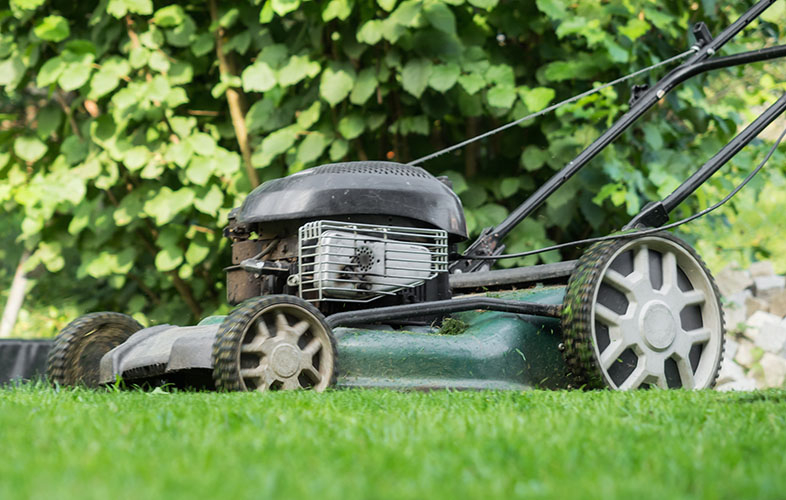If you’re one of the millions living where the sun tends to shine all year round and winters are more mild than our neighbors up north--you know, great states like California, Florida, Georgia, parts of Oregon, Washington and Texas, there’s a good chance that you’ll be living life outside for a good portion of the winter season.

But just because you're not bracing for blizzard conditions doesn't mean your yard won't feel the effects of even slightly cooler temperatures. Here are five easy tips for maintaining your winter yard and trees to have a green Christmas:
1. Use Paint to Prevent Sunscald and Protect Your Tree From Insects
Sun damage to trees, also known as sunscald, doesn’t just occur in the summer. In fact, many trees experience more sun damage in the winter months than they do in the summer months.
Trees are especially vulnerable this season when temperatures are warm during the day but dip to near freezing at night.
Sunscald can stunt a young tree’s growth and cause withered brown spots on leaves, stems and trunks. It can also burn the bark and cause trees to die.
To help reduce sun exposure and damage, you can paint the exposed parts of thin-skinned tree trunks with white latex paint (never use oil-based paint). This is ideal for citrus, peach, plum, apple and pear trees. In addition to preventing sun damage, painting the tree trunks will help avoid cracking and splitting of new bark – which puts the trees at risk to disease, insects and fungus – all of which can turn the greenest tree yellow and brown.
A painted trunk can also highlight insect infestations and may prevent some borers. Palm trees can also benefit from being painted. The paint creates a barrier between the tree and insects that can climb trunks and wreak havoc.
You can add a repellent like lime or something sticky like oil to the white latex paint to trap the insects and prevent them from reaching other parts of the tree.
2. Spread Mulch to Keep Plants Warm
During winter months, warm plants are more likely to stay healthy and green. Think of mulch as your yard’s winter parka: it helps maintain the warmth in soil for trees, plants and shrubs.
For best results, layer 2-to-4 inches of mulch around the perimeter of the plant.
Although freezing temperatures are rare in the warm winter climate states, there are occasions when temperatures can drop significantly. If freezing temperatures are expected, it’s important to check soil moisture levels and spread your mulch prior to a temperature drop.
When the soil has sufficient moisture in the early cold months, mulch can protect your plant throughout the winter.
3. Cover Your Plants to Prevent Freezing
Have you ever seen plants with the brown, crispy leaves covering them after a freeze? This happens when ice crystals form on the top of the leaves, sucking out the life-giving moisture from the leaf.
For the best chance at preventing that frostbitten look on your trees and plants, cover them up.
Here’s how it works: During the day the sun acts as a natural heat lamp, warming the ground. At night when temperatures drop, the soil releases the warmth your plants need to survive. By covering your plants you’ll be able to capture that heat and protect your plants.
Be sure to take coverings off during the day to allow air and sunlight to reach the plant and to prevent condensation from freezing the next night.
The best type of covering is a frost cloth, but your plants aren’t too picky! Any old sheet or blanket will work. The only exception is plastic-type coverings. Those are a no-go because they seal in condensation, which can cause freezing.
4. Rake to Prevent Thatch
Our motto for a healthy lawn this winter: rake on! Raking leaves during this time of year helps prevent a buildup of thatch, that layer of dead plant material that collects between grass and soil.
Thatch isn’t all bad, though. A healthy amount actually helps protect your grass’ roots, but too much prevents grass from reaching its full potential by cutting it off from moisture, oxygen and nutrients.
So how do you know if your lawn has too much thatch? Try this test: Remove a plug of lawn and measure the layer of thatch between the top growth and the root zone. It the thatch is more than 1/2” in depth, it’s time to dethatch your lawn.
We recommend using a thatching rake from a home improvement store. It slices into the lawn and will bring up a lot of the dead material.
Make sure to rake in in two directions at 90 degree angles to one another to prevent damage to grass roots. Once you get rid of the thatch layer, you can put your lawn back in order with a metal leaf rake.
And the collection of thatch you now have? That can be composted and used in the garden. Consider it a holiday bonus!
5. Create a Tailored Plan for Your Lawn
The best tip we can give this season is to find the best lawn care services for your yard.
We can help you protect your plants and lawn by customizing a unique lawn care plan designed for your needs. We recommend starting with a TruGreen Healthy Lawn Analysis® so you can learn more about what can help protect your lawn from the elements this winter and how to get it healthy for spring.
To learn more about TruGreen lawn care services call 866.688.6722 or visit TruGreen.com. You can also check us out on Facebook, Twitter, YouTube and Pinterest.













